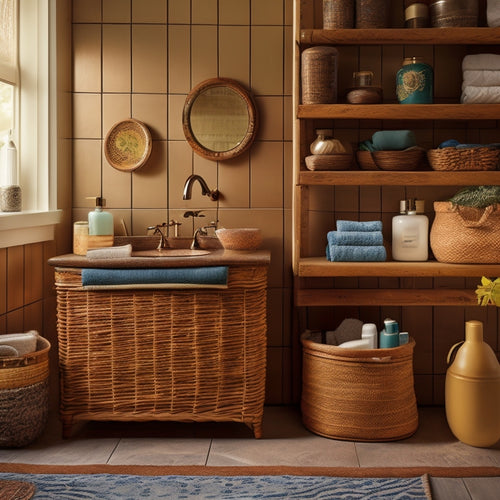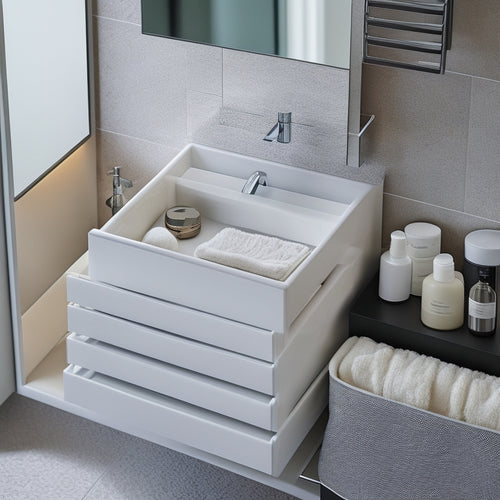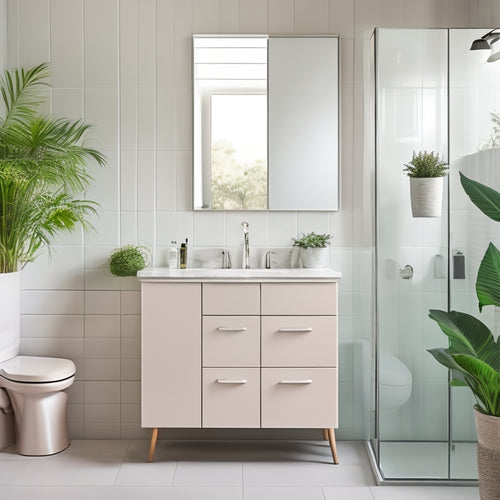
7 Simple Bathroom Shelf Installation Tips
Share
To start your bathroom shelf installation, begin by measuring your bathroom space, considering fixtures and obstacles, and determining the shelf's purpose. Next, choose the right shelf type, balancing durability, style, and functionality. Gather necessary tools, including a drill, level, and screws, based on shelf weight and wall type. Then, prepare the wall by inspecting for cracks, identifying the wall type, and cleaning the surface. Finally, level the shelf and secure it to the wall using appropriate anchors and screws. By following these simple steps, you'll be well on your way to a successful installation, and there's still more to learn to guarantee your project turns out perfectly.
Key Takeaways
- Measure the bathroom space accurately, considering fixtures and obstacles, to determine the ideal shelf placement and size.
- Choose the right shelf type based on material durability, style, and functionality to ensure a suitable fit for your bathroom.
- Prepare the wall for installation by inspecting for cracks, identifying the wall type, and cleaning the surface to ensure proper adhesion.
- Use a leveling tool to achieve perfect alignment and secure the shelf with appropriate anchors for the wall type to prevent damage or instability.
- Regularly check the shelf for loose screws, cleanliness, and signs of mold or moisture damage to maintain its functionality and appearance.
Measure the Bathroom Space
Take all the bathroom's fixtures into account when measuring the space. Don't forget the toilet, sink, shower, and bathtub – they're all essential to determining the perfect shelf placement. Grab a tape measure and get to work! Record the bathroom dimensions, including the width, length, and any obstacles like windows or doors.
Next, think about the shelf's purpose. Are you storing toiletries, towels, or decorative items? This will help you decide where to place the shelf and how much space you'll need. Consider the height at which you'll be placing the shelf, too. You don't want it to be so high that you need a ladder to reach it, but not so low that it's in the way.
Once you have your measurements and a clear idea of what you're storing, start thinking about shelf placement. Will it go above the sink, near the shower, or over the toilet?
Make a mental (or actual) map of your bathroom, and visualize where the shelf will fit best. With these measurements and considerations in mind, you'll be well on your way to finding the perfect spot for your new shelf.
Choose the Right Shelf Type
You'll need to choose a shelf type that fits your bathroom's unique needs and style.
Consider the material - glass, metal, or wood - and how it will hold up to humidity and water exposure.
Next, think about the style: do you want a modern, floating shelf or a more traditional, decorative one?
Shelf Material Matters
Choosing the right shelf material can make all the difference in the functionality and aesthetic of your bathroom. You want a shelf that's not only visually appealing but also durable enough to withstand the humid environment.
When it comes to shelf material, you've got options. Here are some popular ones to reflect upon:
-
Glass shelves: Sleek, modern, and easy to clean, glass shelves add a touch of refinement to your bathroom. Just be careful not to drop anything heavy on them!
-
Wooden shelves: Wooden shelves bring warmth and coziness to your bathroom. They're also great for adding a rustic or traditional vibe. Just make sure to choose a water-resistant finish to protect them from moisture.
-
Metal shelves: Metal shelves are sturdy, modern, and can be paired with any style. They're also easy to clean and maintain.
-
Acrylic shelves: Acrylic shelves are lightweight, waterproof, and easy to install. They're perfect for a minimalist look.
-
Marble shelves: Marble shelves are luxurious, sophisticated, and add a touch of refinement to your bathroom. They're also durable and can withstand heavy loads.
Shelf Style Fits
Now that you've selected the perfect shelf material, it's time to contemplate the style of your shelf. You want a shelf that not only fits your bathroom's décor but also serves its purpose. You must consider shelf aesthetics – will a floating shelf add a sleek touch or do you prefer a decorative shelf with ornate details?
Think about the style of your bathroom and how the shelf will blend in.
Next, consider shelf functionality – what do you need the shelf for? Do you require a shelf with built-in towel bars or one with a built-in soap dish? If you need storage, look for shelves with cabinets or drawers. If you have limited space, a corner shelf or a wall-mounted shelf might be the way to go.
You must strike a balance between shelf aesthetics and shelf functionality. Don't compromise on either aspect – you want a shelf that's both stylish and useful. Take your time, and you'll find the perfect shelf style to fit your bathroom needs.
Prepare the Wall for Installation
With the shelf and hardware in hand, measuring the wall's layout becomes the next essential step in preparing it for installation.
You'll want to make sure the wall is ready for the shelf, and that means more than just slapping it on and hoping for the best. It's time to get serious about wall surface preparation and wall type considerations.
Here's what you need to do:
-
Check for any cracks or damage on the wall surface. You don't want your shelf to be stuck in a spot that's going to crumble soon.
-
Identify the type of wall you're working with. Is it drywall, concrete, or maybe brick? This will affect the type of fasteners you'll need.
-
Clean the wall of any dirt, grime, or old adhesive. A clean slate is essential for a successful installation.
-
Mark the spot where you'll install the shelf. Measure twice, mark once, and make certain it's level.
-
Take note of any pipes or wires behind the wall. You don't want to drill into something you shouldn't.
Use the Right Fastening Tools
Behind every successful bathroom shelf installation lies the right fastening tools. You don't want your shelf to come crashing down because you didn't use the right screws or anchors. So, take a minute to think about the shelf weight and the wall type you're working with.
If you've got a heavy shelf, you'll need heavy-duty fasteners like toggle bolts or molly bolts. These will provide extra holding power and keep your shelf from falling off the wall.
On the other hand, if your shelf is lightweight, you can get away with using smaller anchors or screws.
For hollow walls, use anchors that expand when screwed in, like plastic or metal anchors. These will provide a secure hold and won't damage the wall.
For solid walls, like concrete or brick, use screws that are specifically designed for that type of wall.
Level the Shelf for Perfection
Your shelf's stability relies on more than just the right fastening tools - it also needs to be perfectly level. A wonky shelf can be a real eyesore, not to mention a safety hazard.
Don't worry, we've you taken care of! To guarantee your shelf is level, follow these simple steps:
- Place your shelf against the wall and use a leveling tool to check its alignment. Yes, it's that easy!
- If your shelf comes with adjustable feet, use them to fine-tune its position.
- For shelves with fixed feet, you may need to add shims to level it out.
- Double-check your shelf's alignment using a trusty old bubble level or a laser level for more accuracy.
- Take a step back and admire your handiwork - your shelf should be perfectly level and ready for installation.
Secure the Shelf to the Wall
Now that your shelf is perfectly level, it's time to secure it to the wall. You've got this far, and you don't want all your hard work to come crashing down because of a few loose screws. Literally.
First, locate the wall studs behind your shelf. You can use a stud finder or knock gently on the wall to find them. This is essential because you want to anchor your shelf to something sturdy, not just drywall.
Next, hold the shelf in place and mark the spot where the screws will go. Make sure they line up with the wall studs.
Now, drill pilot holes and screw the shelf into place. Don't overtighten – you don't want to strip the screws or damage the wall.
Remember to take into account the shelf weight when choosing the type of screws or anchors to use. You don't want your shelf to collapse under the weight of your fancy bathroom accessories.
Add Finishing Touches Safely
The shelf is securely in place, and it's time to add those finishing touches. You've made it this far, and now it's time to put on the final flourishes.
Before you start, remember to keep safety precautions in mind. You don't want to undo all your hard work with a careless mistake.
- Double-check your installation checklist to verify everything is in order
- Put away your power tools and keep sharp objects out of reach
- Keep the area well-lit and clear of clutter
- Take your time, and don't rush the final stages
- Consider enlisting a friend to hold the ladder or provide an extra pair of hands
Frequently Asked Questions
Can I Install a Bathroom Shelf Above a Toilet?
You can totally install a bathroom shelf above the toilet, but consider the shelf height - you don't want to hit your head! Gather your installation materials, like a level and screws, and get ready to create a space for extra toilet paper rolls and decorative flair.
How Do I Clean Behind a Fixed Bathroom Shelf?
Imagine a dusty, forgotten kingdom hiding behind your fixed shelf - it's time to conquer it! You'll need a trusty duster, a gentle cleaner, and a flexible scrubber to defeat the grime. Clean in sections, working top-down, and don't forget those pesky corners for a sparkling shelf maintenance victory!
Can I Use a Bathroom Shelf to Store Towels?
You can totally use a bathroom shelf to store towels, and do it like a pro! Opt for shelves made of water-resistant materials, like stainless steel or glass, and implement a towel organization system that keeps them folded, rolled, or hung neatly.
Will a Bathroom Shelf Damage My Tile or Drywall?
Imagine a delicate dancer on a tightrope - that's your tile or drywall. You won't let them plummet if you choose a shelf that's not too heavy, and use anchors or screws that grip like a gentle hug, not a crushing squeeze.
Do I Need a Permit to Install a Bathroom Shelf?
You won't need a permit to install a bathroom shelf, unless you're planning a major renovation or electrical work. Check local permit requirements for shelf types, like floating or recessed, to verify you're good to go!
Conclusion
With these 7 simple bathroom shelf installation tips, you've successfully changed your bathroom into a haven of organization and style. Your newly installed shelf is now a sturdy anchor, holding all your essentials within easy reach. As you step back to admire your handiwork, imagine the cluttered chaos of before melting away like morning mist, replaced by a sense of serenity and calm. Your bathroom shelf is now a guide of tranquility, shining bright in a space that's truly yours.
Related Posts
-

Vintage Bathroom Storage Ideas for Large Families
You can easily boost your large family's bathroom with vintage storage ideas that marry style and function. Think rep...
-

Space-Optimized Drawer Systems for Bathrooms
Space-optimized drawer systems can totally revolutionize your bathroom's storage. By utilizing vertical space and inn...
-

Space-Saving Bathroom Storage With Slimline Cabinets
Slimline cabinets are your perfect solution for space-saving bathroom storage. They employ vertical space effectively...


